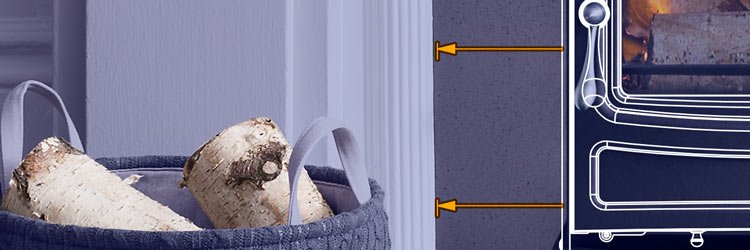
Distance to combustible and non-combustible materials
What is meant by 'Clearance to combustible materials'?
This is really a question of how large a space should you have around my stove in terms of fire safety.
If you have temporarily introduced combustible materials inside the combustible 'clearance' area, then this close proxmity of hot stove and combustible material is a potential fire hazard.
Similarly, if a stove is being installed, perhaps even in a pre-existing fireplace, then precaution should be taken in terms of the proximity of the stove and non-combustible materials, since the heat produced can cause damage if the stove or non-combustble material is positioned within the stove's specified 'Distance to Non-Combustible Material'.
How large is my stove's combustible material clearance area?
Refer to the Technical Specification table in your stove's user guide, as this will vary from model to model.
Example: Ecoburn 5 (S3) stove
The combustible distances for an Ecoburn 5 (S3) stove fitted only with a single walled flue and no optional rear heat shield either are:
- 700mm from the rear of the stove
- 550mm to either side of the stove
Where the stove has been fitted with a twin-walled flue AND its optional rear heat shield the combustible distances reduce to:
- 75mm from the rear of the stove
- 500mm to either side of the stove
Can I install a (flat-panel type) TV above a stove in a fireplace?
In theory the simple answer is yes, Our Ellere Electric fires do not radiate heat vertically so they are ideal for installing closer to your TV as part of a media wall, Refer to the install guide which will give the basic dimensions you need if you intend to build your own media wall.
But if you have a wood burning / multi fuel stove or gas fire there are some caveats:
Firstly only our inset or cassette body style stoves are tested for their minimum combustible distance above the stove, this distance is given in your stoves user / install guide..
For freestanding stoves we can only suggest a minimum combustible distance above the stove, of 3 x your stoves flue diameter. The vast majority of our stoves have a 127mm /5 inch flue diameter, so an minimum distance above the stove just over 380mm or 15 inches.
Secondly- and perhaps most importantly - since every stove install has its own characteristics, we would highly recommend that you should seek specialist advice from your local Arada stove installer to assess the suitability your installation for example for heat radiated through the chimney breast that may damage to your TV equipment.
Combustible materials
You might have seen some examples on television, online or in magazines where combustible objects such as wood logs are stacked up against the side of a stove, This is fine when used as a decorative feature in the summer, but is not safe when the stove actually needs to be used!
Every model we manufacture is independently tested for a variety of things, one of them is to determine the safe minimum distance to combustible materials.
The safe distance varies according to the stove model, due to the different kW heat outputs, size and the design and construction of each stove and how it operates.
Each stove model generally has the a figure showing the minimum safe distance from each of the following dimensions:
- From the rear of the stove,
- From either side of the stove
- In some cases we show the distance from the top of the stove. Generally this figure is not independently tested and we supply our recommended estimate instead
Look in your manual or your stoves technical specifiation to find these values for your stove. These distances must be adhered to for your safety.
Non-combustible materials
Not allowing for sufficient clearance between or around your stove and non-combustible materials (such as brick work or masonry) will not only damage the stove body over time but also reduce radiant heat into the room, reducing the stove's overall effectiveness.
Whilst there is no legal definition for what this must be, as the manufacturer we suggest that stoves should be installed with a minimum of 100mm clearance to non-combustible materials all around the appliance.
As the nature of each stove installation will vary from property to property, it is difficult to account for every installation, such as when a stove has a rear heat shield and a twin-wall flue fitted. Remember that for regular annual maintenance you or your installer may need to have access to the back of your stove at a later date, Your installer can use their discretion in combination with our minimum combustible distance recommendation to suggest a safe, practical and optimal recommendation about the distance to non-combustible material in your property.
